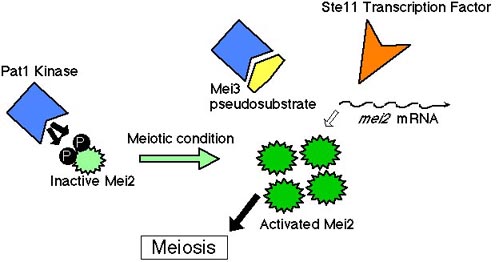We are investigating the molecular mechanism of meiosis using a model organism, fission yeast Schizosaccharomyces pombe. Using the biological simplicity and genetical and biochemical methodology of fission yeast, we can learn the common molecular basis of meiosis which is shared among all eukaryotes including human.
The initiation of meiosis in the fission yeast is determined primarily by enviromental nutrition and cell ploidy (chromosomal DNA content/cell). These two factors are signaled through cAMP, Ras/MAPK and other cascades, to be converted into the Pat1 kinase activity. Active Pat1p represses meiosis during mitotic proliferation, but once Pat1p becomes inactive, cells arrest mitosis and enter meiosis. We have identified an RNA-binding protein Mei2p as the major target of Pat1 kinase. By artificially expressing a mutant form of Mei2 protein that cannot be phosphorylated by Pat1, fission yeast cells initiate meiosis regardless of ploidy and nutritional condition: i.e., Mei2p is the critical switching molecule which selects between two forms of cell division cycle (mitosis and meiosis) in the fission yeast. Besides the switching from mitosis to meiosis, Mei2 also performs an essential role in the progression of meiosis. We have clarified much about the behavior, localization, and regulation of Mei2 protein. Now we are in the way toward the clarification of function(s) of Mei2p.
